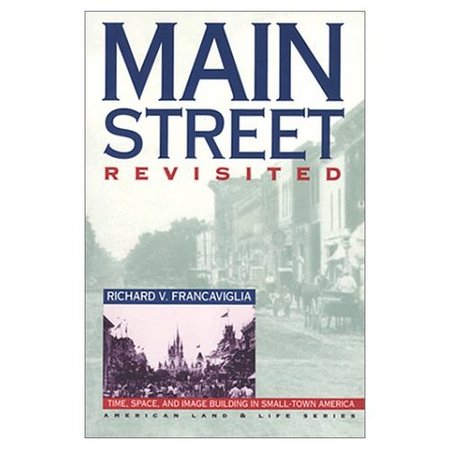October 01, 2009 Categories: Reviews
Main Street Revisited: Time, Space, and Image Building in Small-Town America
1996. University of Iowa Press. 225 pp. $41 (cloth), $21 (paper).
All Main Street is divided into three parts, writes historian and geographer Richard Francaviglia by way of introduction to his survey of American town centers: street patterns, buildings, and open spaces. {xxi} For decades he’s been snooping and taking pictures in American downtowns, and obviously having a good time doing so. In some ways the resulting book is a travelogue and a tour of his findings, but it also makes some arguments.

First, a few tips:
- To estimate when a commercial building was built, go around back. “Unlike the facade, the rear elevation of a commercial building does not attempt to deceive the viewer with stylistic flourishes.” {33}
- If you want an idea of how a city looked when it was small, visit the stable small towns in its hinterland. “Because of their rather arrested development (that is, because they did not develop into major urban centers), many American towns possess an embryonic urban character that has been lost in our cities. Thus, small towns remain treasure troves of historic patterns, and they are best studied as small urban places.” {xxi}
- If you want to change the developmental path a town is on, don’t go in right after a disaster. In both Xenia, Ohio, and Lancaster, Texas, tornadoes led to rebuilding — but it was much more history-oriented in Lancaster than in Xenia, because that had been the trend prior to the disaster. {63}
The book is divided into three chapter-like “sections,” first following the evolution of Main Streets through time, then their differentiation in space, and finally the discussion of “Image Building and Main Street: The Shaping of a Popular American Icon.”
The first section includes an elegant chronological streetscape/timeline prepared by John Wells for the Historic Landmarks Foundation of Indiana in 1978, showing samples of important elements of downtown building styles from Federal to Beaux Arts. {6-7} The second section includes a typology of courthouse squares and a map of their distribution. {92, 94}
Francaviglia is usually pretty noncommital, but he does have an ongoing disagreement with those who contrast the supposed individuality of yesteryear’s small towns with today’s “unimaginative” cookie-cutter malls and strip malls. {165} The record, he says, does not bear these critics out as far as commercial architecture goes. Standard patterns were always the rule. “Even ethnic craftsmen on Main Street of the period [middle and late 1800s] followed mainstream designs that were illustrated in catalogs and building plans; the Main Streets of the period are a testimony to the power of standardized designs in effecting assimilation. Thus, when the late Victorian Italianate-styled Medegovich building was constructed in Bisbee, Arizona, in 1902, only the surname of this entrepreneur appearing on the pedimented gable — and not the architecture or design of the building itself — hinted at the owner’s Serbian ethnicity.” {122} Sinclair Lewis (Main Street) would have agreed.
The book’s third section delves into the interaction between reality and fantasy in downtown landscapes, and it’s elegantly encapsulated in the book’s cover, which consists of a postcard view of Hartford, Michigan, around 1900, with an inset of Disneyland’s Main Street USA. They don’t look much alike. Francaviglia went to Marceline, Missouri, and Fort Collins, Colorado — two of the main sources for the Disney creation — and carefully analyzes the changes made (consciously and otherwise) in adapting the reality to the theme park.
Disney’s adaptations are somewhat drastic but nothing new in principle. Francaviglia notes that even the earliest sketches and photographs of US Main Streets were selective. {135} Selection and adaptation are not sins against architecture or town-making craft, and Disney’s work exemplifies many useful principles. But as Francaviglia notes, these practices can also falsify and sentimentalize history. What Disney’s Main Street portrays as a time of innocence (1890-1910) included the financial panic of 1893 and ensuing depression. “The actions of business would soon lead to a groundswell of populism, even socialism, as scandals rocked the business world and government. And yet, a collective, selective memory as translated by Disney recalls these times as the good old days.” {153} To put it more contentiously than Francaviglia would, Disney’s Main Street is to history as Kentucky’s Creation Museum is to science.
In the end, life imitates art imitating life in an endless game of telephone — or as Francaviglia more elegantly puts it, “All places are both real and imaginary.” {159} Medina, Ohio’s downtown has been gradually rebuilt such that it has become demonstrably more Victorian (architecturally, anyway!) now than it was in the actual Victorian era; it uses “Main Street” as a slogan even though the town itself actually has no such street. {169-174} (One telltale sign of faux history is the naming of “Main Street Hardware” — in the actual 19th century such a store would have borne the proprietor’s name.)
Francaviglia takes note of all this, and astutely draws a comparison with the era when small-town banks were designed to look like the Parthenon. He has gathered a bouquet of facts in a few pages and salted them with a delicate minimum of judgment; you decide.
#
